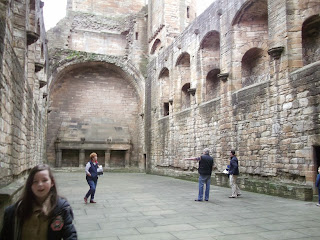 |
| The Impregnable Dumbarton Castle |
Dumbarton's History:
 |
| View of the volcanic rock |
Very little of the medieval castle survives besides the Portcullis Arch and the ruins of the Wallace tower. Today, a visitor will see the gun batteries, Governor's House, French Prisons and powder magazine; all built during the Jacobite rising in the 18th century. According to the official souvenir guide, Dumbarton Rock was 'the strongly fortified British city of Alt Clut'. Built upon an ancient volcano, the 'Rock of the Clyde' has gone through many significant changes up to the 20th century.
It has been a strategic battlement during the reign of King alexander III during his war with King Håkon IV of Norway. Upon defeating the Norsemen relatively little was known about the castle's development other than it being a royal residence.
 |
| Wallace is said to have been held prisoner in this very room |
It was here during the Wars of Independence that the castle housed its first named prisoners, as William Wallace had three English knights sent there clapped in irons. It is believed that Wallace himself was later held prisoner in 1305 before being transported down to London for his execution; it is believed the Wallace Tower within the castle grounds is named so in honour of Scotland's national hero. It is here that Mary Queen of Scots resided in 1548 during the 'rough wooings'.
 |
| Foundations: All that survives of the Wallace Tower |
 |
| Mary Queen of Scots |
Mary was brought here in February 1548 by her mother for her own safety as the English troops ransacked Scotland under the orders of the Duke of Somerset, uncle to King Edward VI. The 'Rough Wooing' itself began almost as soon as King James V died; his uncle King Henry VIII of England sought the match for his son Edward for it would be a great alliance against the French and would bind the Scots to Edward as the future King of both England and Scotland upon marrying Mary.
Of course, such an alliance would go against French interests and Mary's French mother, Marie de Guise, would not accept such an alliance; especially once Henry demanded that Mary be sent to England and brought up in the new Anglican faith. Marie refused and turned to King Henri II for support. Eventually they agreed that Mary would marry his son, Francis. As the situation became more precarious it was decided that Mary would be sent to France and raised there.
 |
| The Clyde river as it is today |
When the French arrived Mary had been living at Dumbarton for six months with her mother. It was here that four French galleys came in July 1548 and spirited the little Queen of Scots to France while her mother remained behind to defend her daughter's crown.
Upon her return Mary only visited the Castle once in 1563 during a royal progress. When she was overthrown in favour of her son, a group of supporters took up residence inside the castle in 1568, remaining there for three years before a raiding party scaled the castle's precipitous slope at night, taking them by surprise.
 |
| A model of the castle during Mary's stay |
After Mary:
 |
| The French prison built around 1790 |
Dumbarton later carried on as a state prison, guarding such men as Patrick Stewart, 2nd Earl of Orkney. From supporters of Bonnie Prince Charlie to French Generals of the Napoleanic wars were housed within the grounds of Dumbarton. By the 19th century the castle had become a prime tourist attraction despite still being a garrison. Even as recent as WWII an anti-aircraft battery was set up at the top of the rock itself; on 5-6 May 1941 that Dumbarton Castle saw its first enemy attack in over 300 years when the German Luftwaffe dropped four high explosive bombs upon the rock.
Today:
 |
| The Gunpowder Battery |
Visitors to the castle can witness several ages of history with the Rock's defenses, as well as viewing spectacular sights around the Clyde and over the Dumbarton town itself. It has seen so much war and peace over the centuries from the Viking raids to Mary's departure to France; from Queen Victoria visiting in 1847 to its attack in 1941. To this day it stands, emersed in history and a testament to its enduring impact today.
 |
| A beautiful view of the rock |
Further reading:
Dumbarton Castle Souvenir Guide; Historic Scotland, 2007
Historic Dumbarton; P Dennison and R Colman, 1999
Excavations at Alt Clut, Clyde Rock, Strathclyde, 1947-1975; L & E Alcock, 1990
.jpg)












